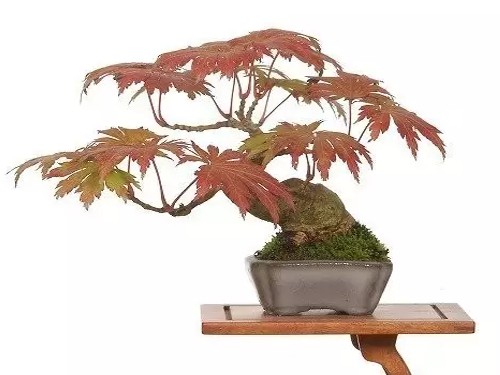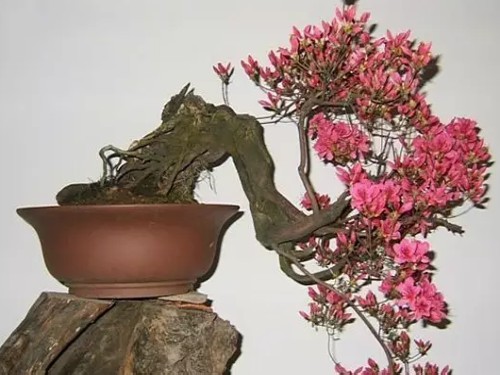Time, method and principle of bonsai fertilization
Bonsai has less soil and limited nutrients, so it must be replenished constantly, otherwise the branches, weak leaves, yellow flowers and sparse fruits will affect the ornamental effect. At the same time, bonsai plants to inhibit their growth, generally do not need to fertilize too much, more application is easy to make the branches and leaves grow too dense, affecting the shape. Therefore, fertilization should be reasonable and appropriate. First of all, it is necessary to master the requirements of various tree species for fertilizer and the demand for fertilizer in different periods, so as to adjust measures to the times according to the tree; secondly, we must master the nature and composition of a variety of fertilizers in order to achieve the desired results.
The time of fertilization is generally the application of quick-acting fertilizer in the prosperous period of plant growth and the use of slow-acting fertilizer in the dormant period. It is not suitable to apply fertilizer during the rainy season and autumn rainy season. Topdressing during the growing period is best carried out when the basin soil is slightly dry on a sunny day, so the potted trees are hungry and thirsty, and the absorption effect is good. Fertilizing in rainy days or wet soil conditions, fertilizer is easy to lose, but also cause rotten roots.
The fertilization of bonsai is the same as that of potted flowers, which requires "thin fertilizer and frequent watering". Especially at the beginning of the growing period, excessive fertilizer will cause dehydration and injury in the roots of the plant, resulting in "plasmolysis" of the plant cells. if it is light, some branches and leaves will wither, and the whole plant will die. To be specific: thin is seven parts of water and three parts of fertilizer, and frequently it is applied about once a week. Bonsai topdressing should first loosen the soil, the basin soil surface with shovel loose, in order to facilitate fertilizer infiltration, reduce the loss; fertilizer liquid should not touch the stem, leaves, sent down along the edge of the basin. "return water" the next morning after fertilization, so as to avoid fertilizer damage.
Bonsai fertilization is mainly organic fertilizer. If you need liquid fertilizer based on nitrogen fertilizer, plant residues such as bean cake can be placed in the jar and jar and retted with water. If you need liquid fertilizer based on phosphorus and potassium fertilizer, use more animal impurities such as chicken dung, dead fish and plant ash into the tank, retting with water. Retting time: generally more than 15 days in summer and more than a month in autumn and winter.
The fertilization of bonsai depends on the species of trees, the height of the pot and the purpose of ornamental. Such as five-needle pine, ivy, yellow poplar, elm, sparrow plum and other bonsai mainly to view leaves, generally nitrogen fertilizer, phosphorus, potash fertilizer for supplement. However, as bonsai planting, the leaves of foliage trees should not be too large, too thick, so fertilization should not be too frequent, too much. Bonsai with flowers and fruits, such as wisteria, pyracantha, begonia, pomegranate, Phyllostachys pubescens, Lycium barbarum, etc., should apply more phosphate and potash fertilizer in addition to nitrogen fertilizer.
In order to promote foliage bonsai branches with strong leaves and luxuriant leaves, flowers and fruits bonsai flowers and large fruits, foliar fertilizer can be sprayed during the vigorous period of plant growth. For example, foliage bonsai can be sprayed with 0.3% urea water; flowering and fruit bonsai can be sprayed with 0.05% boric acid fertilizer as base fertilizer and 0.5% superphosphate leaching solution as foliar spray. In addition, when bonsai is put on the basin or changed, some mature organic compost can be added to the basin soil as the base compost, which is usually applied once before germination in spring to make the branches and leaves strong. Fertilizer should be applied frequently in the period of flower bud differentiation and post-anthesis fruit expansion of bonsai. At the same time, the following points should be paid attention to when applying fertilizer:
1. Organic fertilizers must be fully mature before they can be used.
2. Under any circumstances, the concentrated fertilizer solution should not be poured directly into the basin and must be diluted before it can be used.
3. Bonsai which is newly put into the basin and has not yet taken root should not be fertilized.
4. Fertilize after the basin soil dries a little in the evening, but not in rainy days.
5. Fertilizing must be watered with "turning back water" the next morning.
Fertilizer is closely related to plant growth and development. Especially potted plants, due to the long-term growth in the pot, the root growth is limited by the pot soil, and the range of nutrient uptake is small. There must be an adequate supply of fertilizer in order to ensure normal growth and development, so fertilization is more important. Bonsai fertilization should grasp the following principles:
1. Fertilization must be timely.
Timely fertilization is to fertilize flowers when they need fertilizer, and it is most appropriate to apply fertilizer when it is found that the leaves of the plants become lighter and the growth is weak.
2. Fertilization must be appropriate.
Fertilization must be applied differently according to the different growth stages of flowers. For example, at the seedling stage, there should be more nitrogen fertilizer, fertilizer and water, and more times, so as to promote the rapid and robust growth of seedlings, more phosphorus and potassium fertilizer, more nitrogen fertilizer to make the leaves green, and more phosphorus and potassium fertilizer to flowers and fruits, so as to make the plants blossom and bear fruit early, and make the flowers and fruits brightly colored.
3. The soil must be loosened when applying fertilizer.
Before applying thin liquid fertilizer to potted flowers, the surface of potted soil should be raked loose, and then fertilized until the potted soil is slightly dry. After fertilization, the leaves should be sprayed with water immediately so as not to pollute the leaves with residual liquid. Water must be watered the next day of fertilization.
4. Fertilizing must master the season.
Flowers grow rapidly and vigorously in spring and summer, and can be fertilized more. Flowers grow slowly after autumn, and should be fertilized less. They should be dormant in winter and should stop fertilizing.
5. Time must be mastered in fertilizing.
Fertilization of potted flowers should adopt the principle of "eat less and eat more" (that is, "thin fertilizer is applied frequently"). Generally, thin fertilizer and water can be applied every 7-10 days from the beginning of spring to the Beginning of Autumn, and 15-20 days after the beginning of autumn.
6. Temperature must be mastered in fertilization.
Fertilization should be carried out on a sunny day. Potted flowers should not be fertilized around noon when the summer temperature is high, because the pot soil temperature is high, topdressing is easy to hurt roots, and the effect of application in the evening is the best.
Time: 2019-06-10 Click:
- Prev

Fertilization technique of bonsai in autumn
The general characteristic of tree growth is that the shoot has been Lignified in spring and summer, and a new root and leaf system has been formed, which increases the assimilation area of trees and accumulates nutrients for autumn shoot and flower bud differentiation. The autumn shoot growth and flower bud differentiation of evergreen trees are carried out at the same time, the competition for nutrient distribution is fierce, and vegetative growth is superior to reproductive growth.
- Next

How to fertilize bonsai flowers? What if I apply too much fertilizer?
Fertilization is mainly based on the requirements of ecological conditions and biological characteristics of flowers, pay attention to the relative balance of the three elements of fertilizer, as well as the composition of soil, the characteristics of fertilizer and other factors to determine the choice of fertilizer. 1. Fertilizer characteristics: fertilizer is divided into organic fertilizer and inorganic fertilizer.
Related
- Fuxing push coffee new agricultural production and marketing class: lack of small-scale processing plants
- Jujube rice field leisure farm deep ploughing Yilan for five years to create a space for organic food and play
- Nongyu Farm-A trial of organic papaya for brave women with advanced technology
- Four points for attention in the prevention and control of diseases and insect pests of edible fungi
- How to add nutrient solution to Edible Fungi
- Is there any good way to control edible fungus mites?
- Open Inoculation Technology of Edible Fungi
- Is there any clever way to use fertilizer for edible fungus in winter?
- What agents are used to kill the pathogens of edible fungi in the mushroom shed?
- Rapid drying of Edible Fungi

